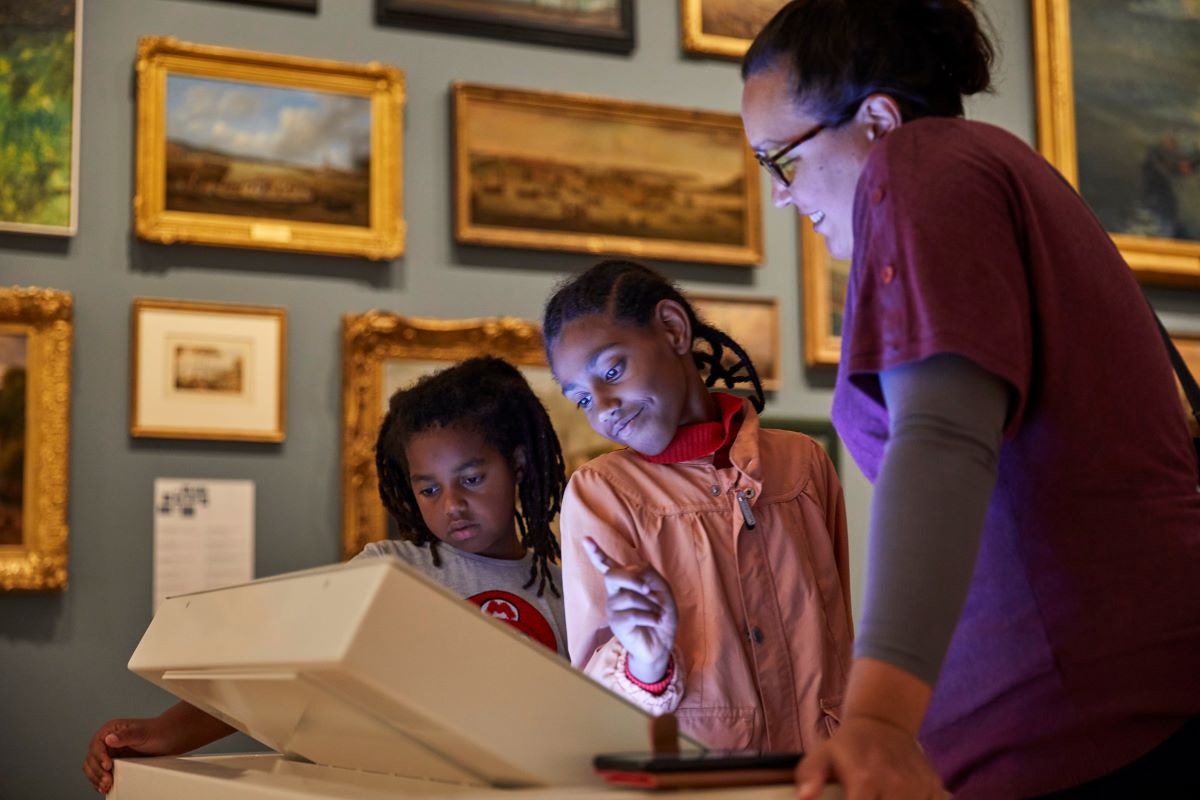
Visitors at The Box, Plymouth, 2021
Photo: © Janie Airey / Art Fund 2021
Local museums are much loved, but their future is uncertain
A new report into the challenges facing the museum and gallery sector has just been published. Rachael Browning outlines its key findings and the policy recommendations emerging from it.
Art Fund marked its 120th anniversary last year. Since 1903, we’ve helped museums and galleries across the UK build their collections, open them up to the public and inspire audiences. However, it’s the events of the most recent years that have had the biggest impact on the sector, its workforce, its audiences, and its future.
The publication of our latest Museum Directors Research marks the fourth time since 2020 that we have asked directors about the challenges their organisations are facing, their current priorities and future opportunities. This was critical in a general election year for us to be able to advocate on their behalf with policymakers and politicians.
Local museums highly valued
Despite the upheaval and precarity of the past four years there is some good news. Visitor numbers are on the rise, with over half of venues at or above pre-pandemic levels. One of the biggest growth areas has been in learning visits, with teachers and children re-engaging enthusiastically.
And as museums look to the year ahead, we see a determination to engage local audiences, and to work alongside them collaboratively, creating meaningful partnerships. This focus on local communities speaks to the directors’ commitment to ensure their institutions creatively serve those on their doorstep, who both deserve and need them, and for whom the museums were created in the first instance.
Our research coincides with a survey we commissioned jointly with the National Museum Directors’ Council (NMDC) which demonstrates how highly the UK public value their museums. Nearly nine in ten UK adults think museums are important to UK culture, with almost half of UK adults visiting museums at least once a year. Three-quarters of UK adults think having a local museum adds value to their area. People value and love their local museums.
Perilous and uncertain context
Which brings me to the huge pressure faced by local authority reliant organisations which made up more than half of respondents to the Museum Directors’ survey. These include some of our greatest civic institutions – many founded in the late-Victorian decades leading up to the establishment of Art Fund – with the shared view that art should be accessible to all.
But they are in a perilous and uncertain state. The reality of post-pandemic financial fragility, real term funding cuts, ageing buildings and increased overheads is putting them under enormous strain. The impact of the cost-of-living crisis on staff and audiences is the biggest collective challenge facing organisations. Outgoings are just half of the problem; falling income is also a huge worry.
To put that in context, just two years ago, half of all museum directors were concerned about funding shortfalls, that figure is now two thirds. They need a 10 – 20% funding increase just to stabilise their business models.
Despite this difficult context, hope prevails. Museum directors are thinking imaginatively and ambitiously about how they can use their collections to encourage new people through their doors with programming that speaks to a diversity of voices and experience. And there is strength in numbers as more organisations seek to work together on exhibitions. There is an acute awareness of a huge opportunity in achieving proper recognition for the work they do in delivering for their communities.
Championing and advocating for the sector
At Art Fund we are determined to continue to add value and champion the sector. Thanks to our 135,000 members, we can give financial and wider support to fund art, grow audiences and advocate on behalf of museums. And as well as shaping our own programmes in response to what’s most needed, we will share the results of this survey with other funders, agencies and government bodies to encourage them to continue to support and sustain the vital work museums undertake daily.
The Art Fund and NMDC survey, mentioned above, also found that almost half (47%) of all respondents thought museums should be mostly or entirely funded by government, with this figure rising to two-thirds for local museums and local government. In this election year, all parties must take care of these local treasures. Once they are gone, they are lost for ever.
To that end, and based on what we’ve heard, we’re advocating on some clear policy areas for the next government:
• Sustainable funding – an enquiry into regional museum funding to address disparities and equity of public access. And further tax breaks or relief for museums, alongside ways to promote philanthropy.
• Public access to collections – the country’s collections must be protected, sustained, promoted and free to all to access.
• Cultural education – every schoolchild should experience a visit to a museum and gallery every year, as part of the national curriculum.
Rachael Browning is Director of Programmes & Policy at Art Fund.
![]() artfund.org/
artfund.org/
![]() @artfund
@artfund
With thanks to Wafer Hadley for undertaking our Museum Directors’ research and to NMDC for partnering on the YouGov Survey. We are also hugely grateful to the museum leaders who gave their time so generously and shared their insights so thoughtfully.
This article, sponsored and contributed by Art Fund, is part of a series sharing information and expertise to support museums and galleries to recover from the pandemic and develop audiences for the future.
Join the Discussion
You must be logged in to post a comment.